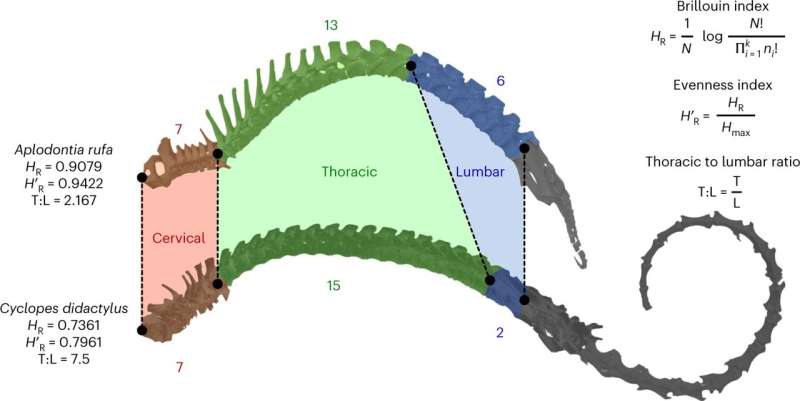This article has been reviewed according to Science X's editorial process and policies. Editors have highlighted the following attributes while ensuring the content's credibility:
fact-checked
peer-reviewed publication
trusted source
proofread
New study shows how mammals have evolved complexity over time

Major changes in the spinal columns of mammals have been shaped by their highly variable numbers of vertebrae, according to new evidence from a team of international scientists, including researchers from the Milner Center for Evolution at the University of Bath.
The team unearthed new findings that identify how this column "complexity" in mammals has been shaped by their varying numbers of vertebrae.
The research group from the University of Lincoln, U.K., the University of Bath and Nanjing Institute of Geology and Paleontology, China, conducted a case study that examined the vertebrae of 1,136 modern mammal species, ranging from blue whales to shrews, to determine how column complexity evolved within major groups over time.
They measured the complexity of the column as a function of the numbers and distributions of vertebrae across the middle and posterior back regions and identified that there was a tendency for complexity to increase in parallel in independent lineages of mammals.
Emily Green, Ph.D. student in the Department of Life Sciences at the University of Lincoln, said, "The axial skeleton of mammals is an ideal model system for investigating patterns and processes of evolution in vertebrates, including the origin of biological complexity and its role in propelling further evolutionary changes."
Andrew Brinkworth, Ph.D. student at the Milner Center for Evolution at the University of Bath, explained, "Nature makes copies of things all the time—genes, organs, limbs—and because these copies aren't always perfect, they'll diverge and therefore the organism bearing them will become more complex, purely by chance."
Yimeng Li, researcher at the Nanjing Institute of Geology and Paleontology, added, "Lamarck, in common with many evolutionary biologists of his time, believed there was an inherent 'complexifying force' within living things, so the overall course of evolution was pre-ordained by God. Darwin showed there's no road map and natural selection can act in any direction, including from more to less complex, as in the case of many blind burrowing and cave animals but the zero-force evolutionary law suggests that even natural selection isn't necessary for the evolution of complexity."
The study, titled "Divergent vertebral formulae shape the evolution of axial complexity in mammals," and the findings of this research have been published in Nature Ecology and Evolution.
More information: Yimeng Li et al, Divergent vertebral formulae shape the evolution of axial complexity in mammals, Nature Ecology & Evolution (2023). DOI: 10.1038/s41559-023-01982-5
Journal information: Nature Ecology & Evolution
Provided by University of Bath




















